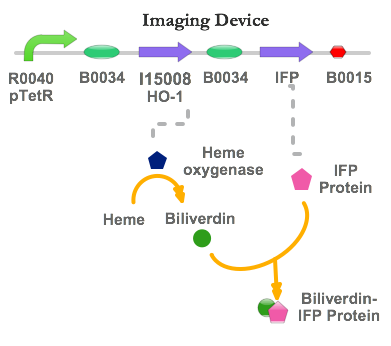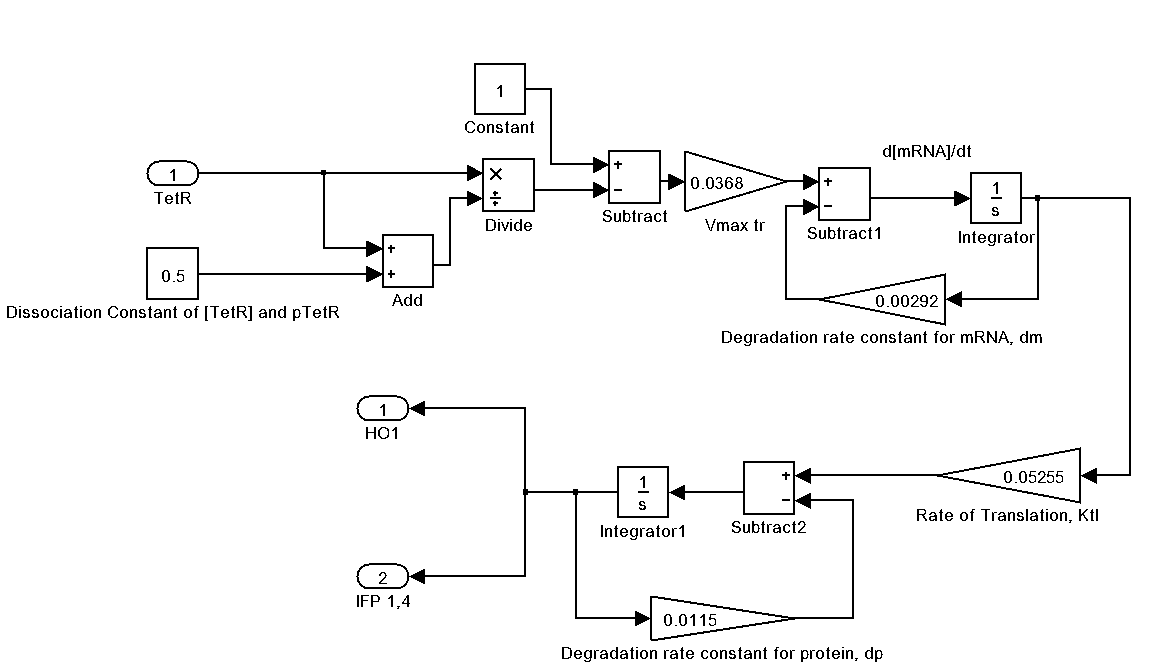Team:NTU-Singapore/Project/Prototype/Image
From 2009.igem.org
| Line 193: | Line 193: | ||
Another approach in ensuring our proteins are expressed is by co-transformation of ampicillin-resistant plasmid of '''J23119-RBS-HO1-T''' and kanamycin-resistant plasmid of '''J23119-RBS-IFP-T''' into the cell. | Another approach in ensuring our proteins are expressed is by co-transformation of ampicillin-resistant plasmid of '''J23119-RBS-HO1-T''' and kanamycin-resistant plasmid of '''J23119-RBS-IFP-T''' into the cell. | ||
| + | |||
| + | Our parts listed above have been verified by confirming the DNA fragments size of the agarose gel electrophoresis of the double digestion and PCR products. 1stBASE has sequenced the part J23119-RBS-IFP-T we have constructed and the results are positive! The summary of the sequencing results is as follows: | ||
| + | |||
| + | <div class="grid_7 alpha"> | ||
| + | [[Image:NTU119-1.png|407px]] | ||
| + | |||
| + | [[Image:NTU119-2.png|407px]] | ||
| + | </div> | ||
| + | |||
| + | |||
| + | |||
| + | '''J23119 Sequencing''' | ||
| + | |||
| + | <span class="grey">Due to the limit of the Sequencer, the first 10 base pairs of the promoter cannot be verified.</span><br class="clear" /> | ||
Revision as of 04:18, 21 October 2009
Imaging Device
The Imaging device is also one of our featured parts.
As we have elaborated earlier in the Prototype Design section, the device consists of mainly pTet regulated expression of IFP & HO-1, which in turn generate a unique fluorescence signal in the infrared spectrum!
We are extremely pleased to report that we have successfully converted this novel reporter protein into a standard Biobrick! Let us now see how exactly the device works.
Abstract
As part of the imaging capability we want for our system, we have eschewed traditional reporter proteins like GFP or YFP and have identified a novel reporter protein, infrared fluorescent protein (IFP). A recent work by Xiaokun et. al. (Tsien Lab, UCSD) has shown successful mammalian expression of infrared fluorescent protein engineered from a bacterial phytochrome. Xiaokun et. al. have also expressed the infrared fluorescent protein in E. coli strain TOP10.
IFP is preferred for our system over other FPs such as GFP or YFP because it has a unique excitation and emission maxima. The wavelength range of IFP fits so well with the wavelength range of typical in vivo optical imaging in deep tissues of animals i.e. between 650 and 900 nm for excitation and emission maxima respectively. This is because this range of wavelength minimizes the absorbance by haemoglobin, water and lipids, as well as light-scattering.
Therefore, IFP is particularly suitable for our ideal system as we desire to locate the atherosclerotic plaque site without invasive procedures.
Background
Our pLaqUe Out! system must be capable of highlighting the atherosclerotic plaque site upon detection by the preceding sensing mechanism of nitric oxide sensing promoter (pNO). The first thing that came to our mind was the variety of known fluorescent proteins (FPs) such as GFP, RFP, YFP, CFP. However, since our ultimate environment for our pLaqUe Out! system is in vivo, we envisioned an ideal system that can express a novel reporter protein with properties suitable for in vivo optical imaging. IFP was chosen as a potential candidate.
The gene encoding IFP used in our expression system is essentially the gene for IFP1.4. Xiaokun et. al. have shown that IFP1.4 was obtained from the gene encoding IFP1.0 by saturation, random mutagenesis, and DNA shuffling; and it was shown to be about four times brighter than IFP1.0, with a relative brightness of 383%.
Fig 1. - Normalized excitation (blue) and emission (red) spectra for Infrared Fluorescent Protein
Overall, IFP has an excitation and emission maxima of 684 nm & 708 nm respectively; compare this with the excitation and emission maxima for other fluorescent proteins, which have not exceeded 598 and 655 nm respectively.
Mechanism
Infrared fluorescent protein is a monomeric protein engineered from a bacterial phytochrome of the species Deinococcus radiodurans.
This bacteriophytochrome incorporates biliverdin IXα (BV) as the chromophore. Biliverdin IXα is in fact a natural product of heme catabolism by the enzyme heme oxygenase-1 (HO-1). BV is essential because in a mouse experiment conducted by Xiaokun et. al., BV has been shown to increase the infrared fluorescence to a maximal fivefold 1 hour after BV injection in the mouse with exogenously added BV.
In a phone call made to Dr. Xiaokun Shu, we have also been told that BV helps to stabilize the infrared fluorescent protein. Hence, it is essential that we incorporate HO-1 into our system to generate biliverdin IXα.
Construct Design
As you recall, our ideal system is designed to be in a T-helper cell chassis. However, for the purpose of expression of the infrared fluorescent protein, we have used E. coli strain K12 as our bacterial expression system. In order to realize the expression system, we incorporate parts i.e. the genes encoding infrared fluorescent protein and heme oxygenase-1 into the device.
The Imaging device is designed to function this way, working only in low [NO] conditions (i.e. in atherosclerotic plaque sites) :
After TetR repression stops at plaque site with low [NO], both HO-1 & IFP are expressed. The HO-1 catalyzes the conversion of haem to biliverdin, which then binds to IFP to allow generation of infrared signal. Once infrared signalling has begun, we can begin imaging for the plaque site from without, and establish the location of the plaque site.
Of course, at this stage we also foresee numerous other medical/non-medical uses for the IFP protein!
Characteristic Equations
Transcription of IFP / HO-1
First, we can define the stoichiometric ration of IFP to HO-1 transcribed.
Next, we establish the deterministic repression-regulated transcription rate of IFP & HO-1.
Where Vmax is max transcription rate & Dm is the degradation rate of mRNA.
Again, bracketed term generates the fraction of pTet not bound with TetR i.e. actively promoting pTet sites.
Translation of IFP / HO-1
Deterministic first order ODE is used again to represent the translation of IFP / HO-1 protein. Same eqn with appropriate term and constants changed.
Where Ktl is the translation rate of mRNA & Dp is the degradation rate of IFP / H0-1 protein.
Infrared signal production
Before the infrared signal can be produced, HO-1 must first convert haem to biliverdin.
And then finally we can determine an equation for rate of infrared signal, (assuming that intensity of infrared signal is directly proportional with the amount of bound-IFP-Biliverdin in the system).
 based on the ratio of bound / activated to total [IFP] available:
based on the ratio of bound / activated to total [IFP] available: 
Modelling & Simulation
We make the following assumptions:
- Biological systems of transcription and translation are assumed to be linear and time-invariant.
- Concentration of the haem is considered to be non-limiting.
- There is no time lag between expression & activity.
- Constant Degradation rates for mRNA as well as protein.
- Intensity of infrared signal is directly proportional to [IFP-BV] complex.
The following is our Sensing device represented as a Simulink system. Please click on it for a larger view.
Device Construction
Researchers at Tsien’s Lab graciously provided us the gene sequence of IFP1.4 optimized for E. coli, and we synthesize the gene encoding IFP1.4 with GeneArt in accordance with the standard stated by the Registry of Standard Biological Parts.
Part: BBa_I15008 from the Registry of Standard Biological Parts contains the HO-1 gene sequence of cyanobacteria, Synechocystis and therefore is extracted directly for our needs.
In order to achieve the final construct as described in the device construction, the following Biobricks have been successfully constructed:
- IFP (synthesized from GeneArt) click here for GeneArt sequencing results
- RBS-HO1
- IFP-T
- RBS-IFP
- RBS-HO1-T
- RBS-IFP-T
- RBS-HO1-RBS-IFP-T
- pTet-RBS-HO1-T
- J23119-RBS-HO1-T
- J23119-RBS-IFP-T
- J23119-RBS-HO1-T-J23119-RBS-IFP-T
- J23119-R-IFP-T in KAN vector
Another approach in ensuring our proteins are expressed is by co-transformation of ampicillin-resistant plasmid of J23119-RBS-HO1-T and kanamycin-resistant plasmid of J23119-RBS-IFP-T into the cell.
Our parts listed above have been verified by confirming the DNA fragments size of the agarose gel electrophoresis of the double digestion and PCR products. 1stBASE has sequenced the part J23119-RBS-IFP-T we have constructed and the results are positive! The summary of the sequencing results is as follows:
J23119 Sequencing
Due to the limit of the Sequencer, the first 10 base pairs of the promoter cannot be verified.
Device Characterization
Literature / References
Please proceed here to view our full list of references.
 "
"







